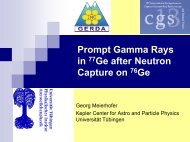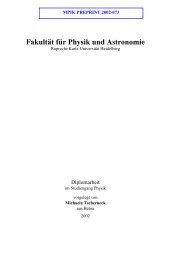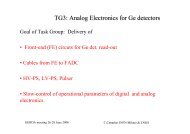Master Thesis
Master Thesis
Master Thesis
You also want an ePaper? Increase the reach of your titles
YUMPU automatically turns print PDFs into web optimized ePapers that Google loves.
8 The search for a cutoff<br />
Now the question will be considered, if we may discover a cutoff in the power spectrum. From this one may conclude a<br />
scale, at which never fluctuations where produced during inflation.<br />
8.1 The CMB<br />
An obvious option is to consider the CMB power spectrum, shown in figure 8.1. The cutoff was introduced at the first<br />
peaks and was of the form(1+10 50∗log(k/k 0) ) −1 , representing nearly a sharp drop. Regarding the figure, it seems to be<br />
difficult to make out a cutoff in the CMB. The highest resolution coming from ACBAR is about l= 3000. According to<br />
equation 4.59 this corresponds to 15M pc or k=0.42M pc −1 . The upcoming Planck satellite should be able to measure<br />
the power spectrum up to l= 2160 with a sensitivity of∆T/T≈ 2.5·10 −6 . Some disadvantages by searching for a cutoff<br />
in the CMB are:<br />
1. 1. The smaller the scales of the cutoff are (= high l) the more smooth is the deviation of the CMB, although a<br />
sharp cutoff was used.<br />
2. The CMB is exponentially damped by the silk damping mechanism by linear increasing l. Therefore it would be<br />
more and more difficult to distinguish the CMB from other radio sources, like for example the milky way.<br />
3. The CMBR is useful for explore huge scales. But the important small scales are rather difficult to resolve.<br />
8.2 CDM power spectra<br />
According to chapter 7, I propose an overall CDM spectrum of density fluctuations:<br />
Linearregime: k100.0h M pc −1<br />
∆ 2 (k) :=∆ 2<br />
cmbeas y (k) (8.1)<br />
∆ 2 (k) := f −1<br />
�<br />
2<br />
cM ∆N L Millennium (k)� = 0.845·∆ 2<br />
N L Millennium · k−0.04<br />
∆ 2 (k) := f −1<br />
� �<br />
cM Ax 3/2 fcM<br />
∆ 2<br />
L<br />
= Akn s+3 T 2 (k)<br />
2π 2<br />
=<br />
��� �<br />
2<br />
3/2<br />
∆L Ak n s+3<br />
�<br />
(8.2)<br />
= 20.92∆ 3<br />
L k0.02 , (8.3)<br />
0.89 ln(15.9k)<br />
783k 2<br />
2π 2<br />
⇒ ∆ 2 (k) = 20.76 � 0.498 ln 2 (15.9)·k −(1−n s)<br />
� 3<br />
� 2<br />
= 0.498 ln 2 (15.9)·k 1−ns<br />
2 , (8.4)<br />
2 k 1−ns<br />
2 = 7.296 ln 3 (15.9k)k −0.04<br />
This ’reference spectrum’ should be valid up to very small scales. A deviation in form of a drop down would be a direct<br />
verification of a cutoff. A comparison of the reference spectrum with current observations has been done in figure 8.2.<br />
Whereas the data coming from SDSS lies well below the estimated power spectrum and may give an evidence for a cutoff,<br />
the Lyman alpha data is far above the spectrum. This is rather inappropriate, because Max Tegmark already produced a<br />
plot, shown in figure 8.3 at which all data fits the expectation very well. The Lyman alpha data reaches scales of about<br />
k= 4h M pc −1 , corresponding toλ=2, 24M pc or l= 20055.<br />
8 The searchfor a cutoff 47<br />
(8.5)
















